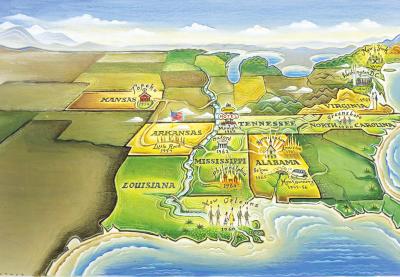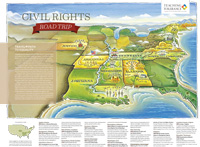Taking a civil rights road trip today is a great way to see America. But in the 1950s and 1960s, traveling the area shown on this map could be difficult and even dangerous.
In 1963, Martin Luther King Jr. wrote about the discrimination that African Americans faced—on the road and elsewhere—and why they were so impatient for change.
“…When you take a cross-country drive and find it necessary to sleep night after night in the uncomfortable corners of your automobile because no motel will accept you … then you will understand why we find it difficult to wait,” he wrote.
King and other African Americans were tired of waiting for civil rights—the right to vote, the right to go to good schools, the right to participate in normal life without fear. The U.S. Constitution guaranteed them those rights. And they were the same rights that white Americans had long enjoyed.
King was not the only activist traveling in this struggle for civil rights. “Freedom Riders” rode buses and risked beatings or jail time to integrate the nation’s transportation system. Civil rights workers drove cars to Mississippi to register and educate voters. And thousands made the long march on foot from Selma to Montgomery in Alabama, calling for the right to vote.
You can travel the path to equality with this Teaching Tolerance map. From the 1954 Brown v. Board of Education ruling to King’s assassination in 1968, this map illustrates an important time and place in our nation’s history.
Use these postcards and posters in your classroom (click the images for larger versions) and check out the related activities below.
Activity 1
Throughout the 1950s and 1960s, brave men, women and children fought in different ways for their civil rights and the rights of those who followed. By tracing in their footsteps, you may begin to think about how you can use your own voice to make positive changes that just may change the lives of those in your community–or perhaps the world–for generations to come.
Vocabulary
boycott [boi kot’] (noun) to refuse to deal with
discrimination [dih-skrim-uh-ney-shuhn] (noun) unfair treatment of a person or group based on prejudice
harmony [hahr-muh-nee] (noun) agreement in action, opinion, feeling
integrate [in-ti-greyt] (verb) to bring together into a whole
segregation [seg-ri-gey-shuhn] (noun) separating or creating separate facilities
Discussion
- A civil right is a right that is guaranteed to citizens by their country’s laws and constitution. What are some examples of your civil rights? Which rights do you most value? How would you feel if those rights were taken away?
- How do you think Ruby Bridges and the Central High students felt as they stood up to powerful people in an attempt to peacefully claim their rights?
- How would you feel if you had to go to a separate school from other people your age, just because you were a different race or religion or had different beliefs?
- In his famous March on Washington speech, Martin Luther King Jr. talked about his dreams for his children’s future. What are your dreams as they relate to equal rights for all?
Geography
Imagine that you have been invited to take a real civil rights road trip! Complete the activities or questions below to help you plan your trip!
- You can bring one other person along with you on the road trip. Whom will you bring and why?
- Your road trip will include five of the destinations on the map. You can choose any five! Write the names below of the places you will visit:
- Once you have chosen your five destinations, find the locations on a real U.S. map. Which is closest to your hometown? Which is farthest? If possible, research the distance you would travel from your hometown to each one of the five destinations and back again.
- What will you need to bring with you on the road trip? Think about the climate, the most appropriate clothing and what will help you best remember this special trip. List at least 10 items you will pack in your suitcase below:
- Visit the websites of the five places you have chosen, to help you visualize what a real visit would be like. Then write a journal entry that describes your imaginary experience at one of the sites.
Act It Out
With a few classmates, choose one of the civil rights stories outlined on the poster and write a one-page script that reflects the actions and feelings of those involved. You may want to do a little extra research about the event or people involved. It’s OK to take a little creative freedom and imagine what you think the people involved would have said and done! Act out your script for the class.
Activity 2
It’s important for students learning about civil rights history to put themselves in the shoes of those who were there. Have them commemorate their own civil rights road trip by writing postcards from the past. This activity helps students imagine being in another place and time by writing about a moment on the path to equality.
Essential Questions
What would it have been like to be a young person living through the civil rights movement and experiencing the events firsthand?
Materials
- “Civil Rights Road Trip: Travel the Path to Equality” map
- Civil Rights Road Trip postcards
- Student Writing Prompts (PDF)
Task
Using the postcards provided, have students write a message from one of the states featured on the civil rights map. Their messages will tell about a key event that took place in that state during the civil rights era.
Step 1 Take your class on a civil rights road trip, using the map and additional information provided in Teaching Tolerance, Spring 2012.
Step 2 Students choose a key event and state to write about. Depending on the time, resources available and grade level, students can do further research on the civil rights events and history from that time and place.
Step 3 Students choose a role and audience for their postcard writing. Here are five suggested prompts for students’ writing. Each prompt includes suggestions for differentiation to accommodate a range of grade and readiness levels (mild, medium, spicy).
Step 4 Students write rough drafts of their message and receive peer and teacher input and editing. Final drafts are written onto the civil rights road trip postcards.
Step 5 Students share what they’ve written by passing their postcards around the room or taking turns reading them aloud to the class. Allow discussion if students have questions for each other.
Activity 3
Essential Questions
What would it have been like to be a young person living through the civil rights movement and experiencing the events firsthand?
Materials
- “Civil Rights Road Trip: Travel the Path to Equality” map
- Civil Rights Road Trip postcards
- Student Writing Prompts (PDF)
Task
Using the postcards provided, have students write a message from one of the states featured on the civil rights map. Their messages will tell about a key event that took place in that state during the civil rights era.
Step 1 Take your class on a civil rights road trip, using the map and additional information provided in Teaching Tolerance, Spring 2012.
Step 2 Students choose a key event and state to write about. Depending on the time, resources available and grade level, students can do further research on the civil rights events and history from that time and place.
Step 3 Students choose a role and audience for their postcard writing. Below are five suggested prompts for students’ writing. Each prompt includes suggestions for differentiation to accommodate a range of grade and readiness levels (mild, medium, spicy).
Prompt A: Imagine you are a young person growing up in a place and time on the civil rights map. Write a postcard to a friend or relative living in another part of the country during that time.
- Mild: What is happening in your state and how do you feel about it? What might you ask your friend or relative?
- Medium: What is happening in your state and how do you feel about it? Include historically accurate facts or details about that event. What help might you ask for from your friend or relative?
- Spicy: What is happening in your state and how do you feel about it? Make a connection to something that’s happened in your friend or relative’s state during that same time period. Include historically accurate facts or details.
Prompt B: Imagine you have traveled back to a place and time on the civil rights map. Write a postcard from that place and time to your present-day self.
- Mild: What did you witness and how did you feel about it? Describe the people, places and events you saw.
- Medium: What did you witness and how did you feel about it? Share how you think things have changed since this time in American history.
- Spicy: What did you witness and how did you feel about it? Connect an issue of equity or social justice from today to a person or event you witnessed on your trip to the civil rights past.
Prompt C: Imagine you have opened your mailbox and found a postcard from the past. A person your age from a place and time on the civil rights map has written to you.
- Mild: What does the person from the past tell you about the events happening in her state? What does he want to know about the future?
- Medium: What is that person’s opinion of the events happening in his state? What concerns does she express about the future? What advice does he give to you based on what she experienced?
- Spicy: What is that person’s perspective on the events happening in his state? What questions and concerns would she express about the future? What request does he make of you and your generation?
Prompt D: Imagine you are a young person growing up in a place and time on the civil rights map. Write a postcard to your grandchildren living in the future.
- Mild: What do you want your grandchildren to learn about this time in history?
- Medium: What do you ask your grandchildren to remember? What lessons can you offer to them for their lifetime?
- Spicy: What do you want your grandchildren to learn and remember about this time in history. What wisdom do you offer them? What is their inherited responsibility from the struggle for civil rights?
Prompt E: Imagine you are a young person growing up in a place and time on the civil rights map. Write a postcard to a public official living at that time, such as civil rights leaders, community figures, mayor, governor, judge, President.
- Mild: What do you think they should do to help the people in your state?
- Medium: What is the main problem facing your state and what solution would you suggest?
- Spicy: What specific action would you like to see leadership take in response to the problems happening in your state? How would you convince them?
Step 4 Students write rough drafts of their message and receive peer and teacher input and editing. Final drafts are written onto the civil rights road trip postcards.
Step 5 Students share what they’ve written by passing their postcards around the room or taking turns reading them aloud to the class. Allow discussion if students have questions for each other.




0 COMMENTS